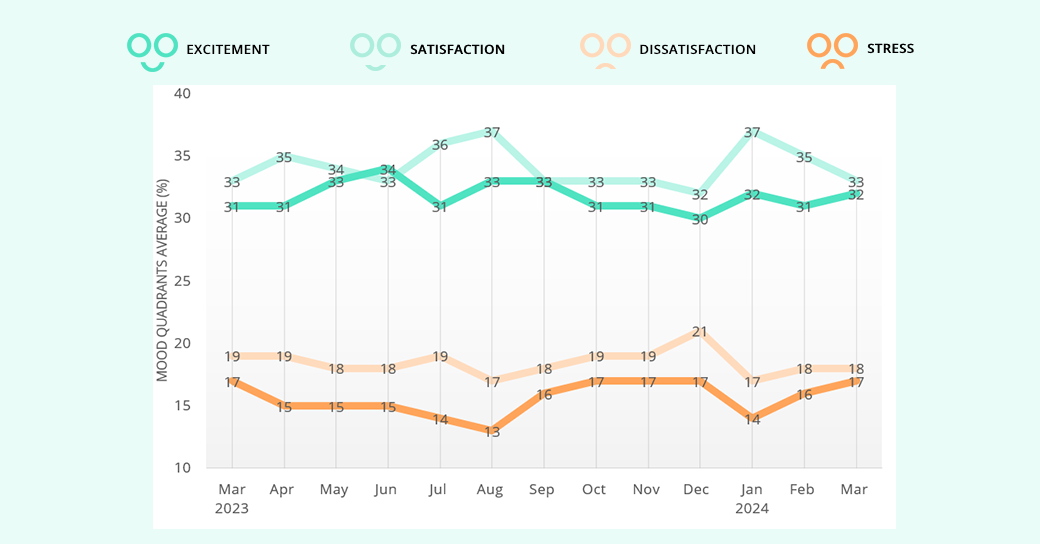Als werkgever is het essentieel om medewerkersfeedback te verzamelen. Medewerkers vinden het ontzettend belangrijk dat er naar hen wordt geluisterd door het management en hun directe leidinggevenden. Toch vormt het jaarlijkse MTO binnen veel organisaties nog een grote frustratie. Met dit stappenplan is jouw medewerkerstevredenheidsonderzoek vanaf nu een eitje!
Door de traditionele manier van meten kan een MTO erg saai zijn, lang duren om in te vullen, en belangrijker nog: het vindt slechts (twee)jaarlijks plaats. En jaarlijkse metingen tonen alleen momentopnamen. Ze laten zien hoe het er op dát moment voorstaat met betrokkenheid en werkgeluk. Ook duurt het meestal even voordat de onderzoeksresultaten bekend zijn, waardoor de data dan alweer een verouderde situatie laat zien. Wij geloven dat dit anders kan én moet. Wij zien het MTO als een film, niet een foto.
Stappenplan medewerkerstevredenheidsonderzoek
Om een effectief en efficiënt medewerkerstevredenheidsonderzoek uit te voeren, is het belangrijk dat dit op een aantrekkelijke manier gebeurt. Steeds meer bedrijven zetten daarom de stap van traditionele jaarlijkse metingen naar pulse- of continue metingen, waarmee je altijd actuele data kunt terugkoppelen, doelgericht actie kunt ondernemen en het effect daarvan direct weer kunt meten. Zo weet je meteen of je acties een positief effect hebben op de medewerkersbetrokkenheid of het werkgeluk.
Ben je benieuwd hoe je de overstap kunt maken naar een continue inzet van het MTO? Aan de hand van dit stappenplan ontdek je hoe je het medewerkerstevredenheidsonderzoek als kort-cyclische meting inzet. Zo krijg je snel inzichten over stappen waar jij als directeur, HR of teamleider mee aan de slag kunt!
Wil je meer weten over hoe 2DAYSMOOD bij iedere stap kan helpen? Vraag dan een vrijblijvende kennismaking of adviesgesprek aan. Onze Employee Happiness expert helpt jou graag met de opzet van je stappenplan en het medewerkerstevredenheidsonderzoek!
STAP 1. Begin bij de basis
Om als organisatie te meten (en dus te weten) waar je staat, kan een nulmeting niet ontbreken. Een nulmeting brengt de huidige situatie in kaart en vormt je uitgangspunt voor verder onderzoek en het ondernemen van actie. Als er geen gegevens zijn over jouw beginsituatie, is het ook lastig om te zien of doorgevoerde veranderingen daadwerkelijk effect hebben gehad. Er is immers geen vergelijkingsmateriaal.
Door een nulmeting te doen zorg je ervoor dat er wél gegevens zijn van de beginsituatie. Zo kun je na het doorvoeren van veranderingen makkelijk vergelijken of ze effect hebben op het werkgeluk en de betrokkenheid van je medewerkers. Wil je dat doen met een slimme, makkelijke en korte vragenlijst? Met onze nulmeting heb je snel inzichtelijke data.
STAP 2. Hoe ziet je uitgangssituatie eruit?
Zodra de nulmeting is afgelopen, is het belangrijk om zo snel mogelijk met de data aan de slag te gaan. De eerste stap is om deze data als directie en HR te analyseren en bespreken. Wat zijn (probleem)gebieden waarvoor directe aandacht vereist is? Herken je deze problemen? Of is de oorzaak onbekend?
Kijk ook naar dingen die goed gaan. Wat zijn de succesfactoren? Of zijn er dingen die wellicht eenvoudig verbeterd kunnen worden? Probeer in ieder geval samen de achterliggende oorzaken te achterhalen door de uitkomsten te bespreken. Schetsen de uitkomsten een gewenste situatie van de organisatie? Of is er werk aan de winkel? Het is belangrijk dat iedereen dezelfde richting op wil en dat iedereen zich verantwoordelijk voelt voor de benodigde veranderingen.
STAP 3. Welke prioriteiten moet je stellen?
Niet alle onderwerpen hebben dezelfde prioriteit, of dienen per direct opgelost te worden. Hoe meer onderwerpen je wil aanpakken, hoe groter de kans dat een deel niet wordt opgepakt en uiteindelijk blijft liggen. Hierdoor verlies je de medewerkers in het proces. Zij zullen zich dan minder betrokken voelen. Pas hiervoor op! Het is een echte dooddoener voor een medewerkersonderzoek.
Stel op basis van de nulmeting-uitkomsten vast welke knelpunten je als eerste oppakt. Welke zaken hebben de meeste urgentie? Waar valt de grootste verbetering te behalen? Maak onderscheid tussen korte en lange termijn prioriteiten en tussen organisatiebrede en afdelingsspecifieke prioriteiten.
STAP 4. Kies een focus en startpunt
Het liefst zou je natuurlijk 15 ballen tegelijk in de lucht houden. Maar je bent in je organisatie liever niet de goochelaar die met deze belangrijke onderwerpen gaat jongleren. Het is gewoonweg niet realistisch om alles tegelijkertijd op te lossen. Begin op basis van je prioriteiten altijd met één of twee onderwerpen als focus. Zet hier verdiepende metingen voor in, om meer diepgaande feedback te verzamelen binnen het aandachtsgebied.
STAP 5. Je focusonderwerp verdient extra aandacht!
Ga ongeveer twee tot drie maanden aan de slag met het onderwerp dat centraal staat. Zorg ervoor dat iedereen in de organisatie op de hoogte is van jouw focusonderwerp voor de komende tijd. Zo kan iedereen meedenken in verbeteringen en eigenaar worden van actieplannen voor verandering.
Bekijk altijd welke interventies of tools er al in de organisatie aanwezig zijn met betrekking tot het onderwerp. Misschien zijn deze initiatieven gewoon onderbelicht. Zet ze in de spotlight en gebruik meerdere effectieve communicatiekanalen. Vaak zijn medewerkers onvoldoende op de hoogte wat er allemaal al voor ze wordt gedaan. En dat is zonde, toch?
Stimuleer ook de dialoog binnen en tussen teams. Nodig medewerkers uit om met ideeën te komen en initiatieven te starten die de ontwikkeling van henzelf, maar ook van collega’s of het team bevordert.
STAP 6. Analyseer de verdiepende feedback
Na afloop van een specifieke, verdiepende meting is het essentieel dat je de resultaten bekijkt en analyseert. Waar zit het probleem? Maak een stappenplan: hoe kan dit probleem opgelost worden? Lees je in op het onderwerp of klop aan bij collega’s die er kennis over bezitten. Verzamel naast kwantitatieve informatie (door middel van kort-cyclische metingen) ook kwalitatieve informatie (dialoog met medewerkers en teams).
STAP 7. Wie gaat de opvolging doen?
Zorg ervoor dat binnen elk team iemand verantwoordelijk wordt gemaakt voor het bespreken van de resultaten. Dit hoeft niet per se de leidinggevende te zijn, een medewerker kan hierin ook een voortrekkersrol aannemen of hiervoor benoemd worden door zijn collega’s. Ga op zoek naar deze ambassadeurs in jouw organisatie of in jouw team. Is er iemand met een interesse in data-analytics? Iemand die het leuk vindt om zich te ontwikkelen op leiderschapsskills? Of iemand die een enthousiaste, positieve werkhouding heeft en graag dingen wil aanpakken?
STAP 8. Communiceer je actiepunten
Volg de resultaten op met concrete acties en communiceer hierover! Dit is het meest cruciale onderdeel voor een succesvol uitgevoerd stappenplan van het medewerkerstevredenheidsonderzoek. Het zorgt voor een hoge medewerkersbetrokkenheid die op de lange termijn aanhoudt. Zet meerdere communicatiekanalen tegelijk in. Denk aan een nieuwsbrief, social media, intranet of posters, waar teams een podium kunnen krijgen om hun initiatief of praktijkvoorbeeld te delen met anderen. Probeer ook out-of-the-box te denken. Op welke ludieke manier kun je aandacht en bewustwording creëren?
Naast de verbeteringsacties zul je ook moeten communiceren over dingen die je (op dit moment) niet kunt verbeteren. In sommige gevallen is ‘nee’ ook een goed antwoord. Dit is voor medewerkers best te accepteren als je genoeg uitleg en argumentatie geeft.
STAP 9. Kijk ook waar het goed gaat
Vaak gaat alle aandacht naar de dingen die niet goed gaan in een organisatie. Vergeet je ook niet te richten op de positieve resultaten. Bij welke afdelingen, business units of teams gaat het wél goed? Vier je successen. Geef de betreffende teams een compliment of zet ze zelfs eens extra in het zonnetje. Wellicht kun je er via een interview een mooi succesverhaal uit halen om te delen met de rest van de organisatie. Een nieuwsbericht op het intranet of video in de digitale nieuwsbrief, bijvoorbeeld.
STAP 10. Doe na een halfjaar opnieuw een nulmeting
Nu kun je het effect meten van je acties! Zijn er in de tussentijd nog andere dingen veranderd? Begin weer bij stap 1 van het stappenplan voor je medewerkerstevredenheidsonderzoek en kies je volgende focuspunten. Veel succes! 🙂




